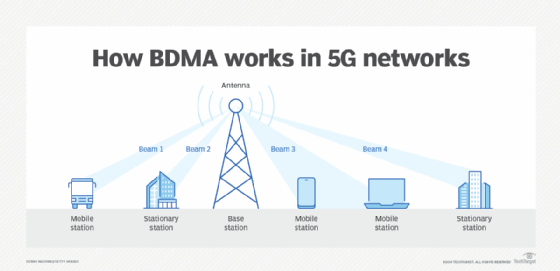
Alex - stock.adobe.com
Beam division multiple access features and their effect on 5G
BDMA, a new multiple access technology, has the potential to boost the efficiency of 5G networks through its use of beam formation and orthogonality.
Enterprises have a new multiple access technique to consider when seeking ways to boost the capacity of their 5G networks: beam division multiple access.
Instead of relying on frequencies to allocate channels, BDMA uses beam formation and orthogonality to target subscribers and increase the network's overall efficiency. Let's examine how this method works and explore key BDMA features.
Multiple access and its importance
Multiple access is a cornerstone of wireless telecommunications systems. As the term implies, the technique enables multiple users to simultaneously share a finite piece of radio spectrum. Each user device can access the available bandwidth at the same time without interfering with the other.
Previous generations of wireless communication technologies used the following multiple access techniques:
- Code division multiple access.
- Frequency division multiple access (FDMA).
- Time division multiple access.
5G has its own set of multiple access techniques, including the following:
- Orthogonal FDMA (OFDMA).
- Single-carrier FDMA.
- Nonorthogonal multiple access, or NOMA.
- BDMA.
BDMA, proposed by scientists at the Korea Advanced Institute of Science and Technology, is the latest addition.
How does BDMA work?
BDMA works by allocating highly directive orthogonal beams to multiple mobile stations in 5G networks. It divides the base station antenna beam according to certain criteria and the location of subscribers within the cell. BDMA uses beamforming pre-coding strategies to improve internet connectivity and reduce interference.
BDMA is independent of frequency, time and code constraints, helping it overcome the limitations of FDMA and orthogonal frequency division multiplexing (OFDM) in wireless communications. Within 5G networks, BDMA enables 5G networks to handle a high number of mobile users, while reducing multiuser interference. In other words, by implementing BDMA, 5G networks can more efficiently harness spectrum capacity even as they boost the number of channels.

Imagine a BDMA-compatible 5G network consisting of a base station with a multiuser multiple input, multiple output (MU-MIMO) array system and multiple mobile stations in a cell.
A broadcast beam identifies required information from the mobile station. Selected subscribers are identified through beamforming, based on various criteria, including the direction of the mobile station and degree of interference. Massive MIMO beams are converted into single-user MIMO beams for efficient communication. Highly directed beams reach multiple target subscribers based on the position, speed and orthogonality of the client device.
BDMA features
Here are some of the major BDMA features that can influence 5G networks.
MU-MIMO base station
The base station in BDMA must support millimeter wave and implement MU-MIMO for beamforming techniques. The base station fetches information about mobile client devices within the cell. It chooses subscribers based on selection criteria. BDMA uses hybrid beamforming to transmit signals from the base station to multiple mobile users within the cell.
Hybrid beamforming
BDMA relies on hybrid beamforming to increase 5G capacity. The hybrid transmitter combines features of digital and analog beamforming. Each RF chain in a hybrid transmitter is connected to antenna arrays in the base station.
Beam properties
Beamforming is used to select MU-MIMO beams at the base station. Each beam is distinct from the other and has a different direction, angle and width depending on the subscriber's position. MU-MIMO beams are converted into subsets for transmission. Each beam group communicates with a selected subscriber device.
Selection of subscribers
Subscribers are selected based on their inability to interfere with other devices in the cell. Various selection techniques compare the degree of independence between each user device. BDMA uses a mathematical vector to measure the degree of independence of user devices in a cell.
Pre-coding techniques
A pre-coder is used to optimize the transmitted signal. In BDMA, various pre-coding techniques -- among them zero forcing and orthogonal beamforming -- are used to reduce interference and improve the efficiency of BDMA-compatible networks.
Beam schedule and transmission
The base station schedules and allocates beams to selected subscribers, depending on the subscriber's position and available throughput. The beams are further divided into subsets, each of which focuses on an individual subscriber in the cell. Using this approach, the beam can serve multiple subscribers in the cell, all of whom can uplink and downlink information after scheduling begins.
Benefits of BDMA
Here are some of the benefits of BDMA:
- Better signal quality and high signal-to-noise ratio in areas with high interference or poor signal strength.
- Lower costs associated with power consumption.
- Secure, safe and difficult for jammers to interfere.
- Ability to focus antenna beams where demand is highest and away from areas with less demand.
- Ability to drop calls for devices with high interference in situations where a large number of subscribers exist within a cell.
Limitations of BDMA
Here are some limitations associated with BDMA:
- Because BDMA is relatively new, implementation can be complex. Fewer compatible devices and base stations support BDMA.
- Subscribers need to be in direct line of sight for effective communication.
- BDMA needs one antenna per user for simultaneous data transmission, which decreases its ability to support a large number of subscribers.
Conclusion
BDMA provides high data rates to mobile subscribers and even higher rates to stationary subscribers in a cell with negligible interference. Even though the vast majority of 5G networks currently rely on OFDM and OFDMA, it's likely more will begin to support BDMA as well.
Venus Kohli is an electronics and telecommunications engineer, having completed her engineering degree from Bharati Vidyapeeth College of Engineering -- Mumbai University in 2019. Kohli works as a technical writer for electronics, electrical, networking and various other technological categories.








